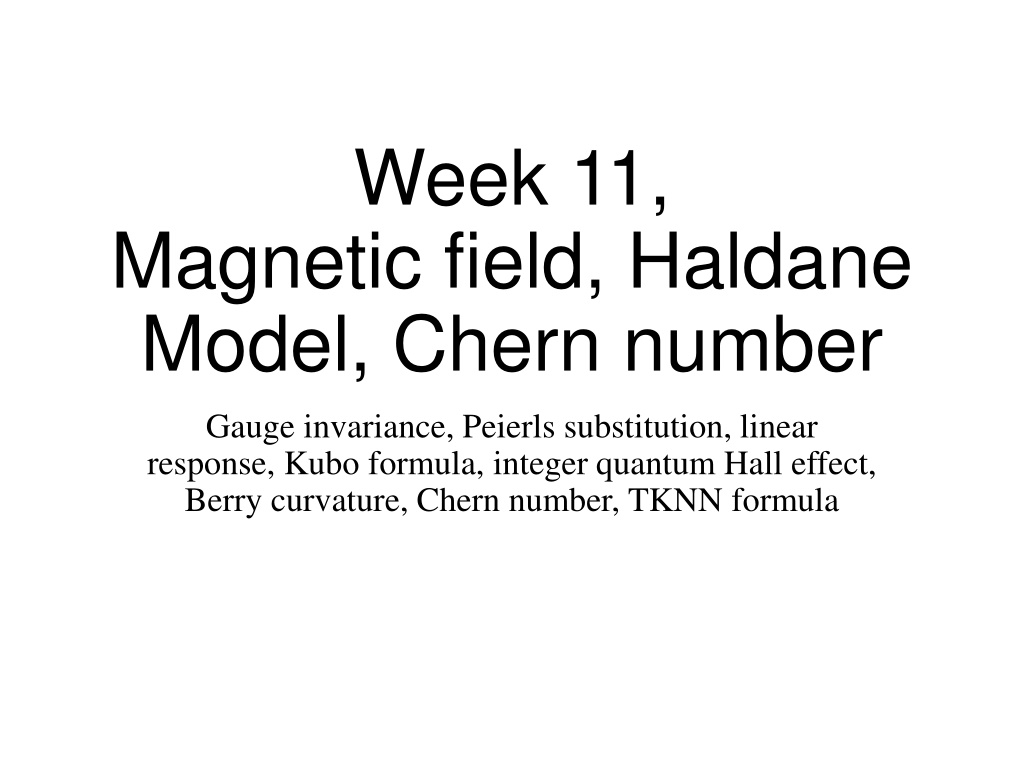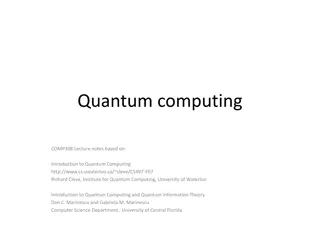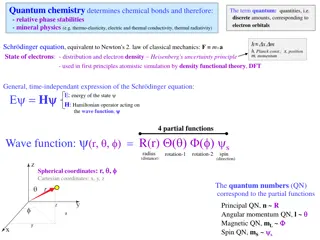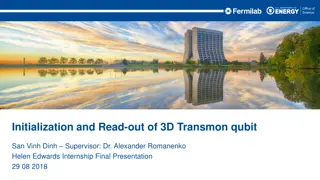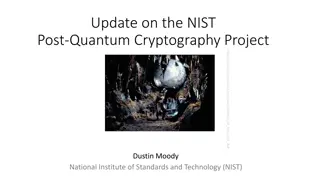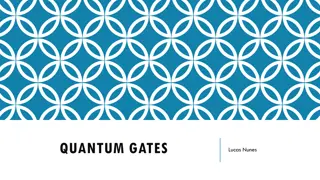Exploring Advanced Topics in Quantum Physics
Dive deep into concepts like the Haldane Model, Chern Numbers, and Linear Response Theory in Quantum Physics. Understand the intricate relationships between magnetic fields, electron Hamiltonians, and conductivity theories. Explore the fascinating world of quantum Hall effects and gauge invariance in condensed matter physics.
Download Presentation

Please find below an Image/Link to download the presentation.
The content on the website is provided AS IS for your information and personal use only. It may not be sold, licensed, or shared on other websites without obtaining consent from the author. Download presentation by click this link. If you encounter any issues during the download, it is possible that the publisher has removed the file from their server.
E N D
Presentation Transcript
Week 11, Magnetic field, Haldane Model, Chern number Gauge invariance, Peierls substitution, linear response, Kubo formula, integer quantum Hall effect, Berry curvature, Chern number, TKNN formula
Electron Hamiltonian in electromagnetic field 2 p A 1 m ( ) 2 + + ) , = = p A B A E ( , e e 2 2 m t Gauge invariance: f t + / ie f A A , , f e e r ( ) i f j electron carries charge ( ) c e c e j j second quantization many-bod y Hamiltonian e j A r i d + e c c j j ( ) r ( ) c Hc c H c e k jk k j j jk j
Haldane model (1988) A ?1 ?? 2 ??2= ?2? B ( ) ( ) js = ( 1) + + + + j j k c c j k h.c. h.c. H c c t t ic c 1 2 j j jk jk : nearest neighbor (sublattice A : next nearest neighbor (on same sublattice, A 1 on sublattice A, 2 on sub B) jk A, or B B) jk = lattice B s j
The Haldane model in k space k ( ) ( ) k c c ( ) k A = A B ( ), k ( ) k ( ) k H c c H B 3 6 ( ) = + + ( ) k k cos( ) sin( ) 2 sin( ) H t t t k k 1 1 2 j x j y j z = = 1 4 j j 0 1 1 0 0 i 1 0 0 i = = = , , ?1 x y z 0 1 ?4 ?1 ??2 ?1,2,3 nearest neighbor vectors denoted by red arrows, ?4,5,6 next nearest neighbor vectors denoted by grey dotted arrows. ?1
Linear response theory for conductivity k ( ) ( ) k c c ( ) k k dH d k A = = = = 3 J r j ( ) ( ) ( ), k V k k V k ( ) k ( ) ( ) , d e c c c ( ) B = = + = = 3 rj A J A ', ' H c Hc d H H H J A tot 0 = , , x y z iH t iH t ( ) ( ) = = = 0 0 H S I I ( ) t Tr ( ) t J Tr ( ) t J t ( ) 0 ( ) J J t e J e S I Generalize to contour time: i i '( ') ' H d ( ) ( ) = ( ) + ( ) '( ') + I 2 I I I ' ( ' ) J T J e T J T J H d O H I H 0 H H 0 0 = ( , ') ( ') ' G A d J J ( ) ( ) H N Tr e 0 = ( ) H ( ) H N Tr e 0 0 1 i ( , ') = ( ) ( ') = I I G T J J J J k T H 0 B
Apply Wicks theorem to compute GJJ ? ,? ?,? k ( ) ( ) k c c ( ) k k dH d k A = = = = 3 J r j ( ) ( ) ( ), k V k k V k ( ) k ( ) ( ) , d e c c c ( ) B i ( , ') = ( ) ( ') = I I , ', , ' or G T J J j j l l A B J J H 0 2 e i ( ) = ( , ) ( ', ') ( ', ') c k k j l ( ) k ( ') k ( , ) k k V V T c c c ' ' ' ' jj ll j l k k , ', , ', , ' j j l l k k k 2 e i = ( , ) ( ', ') c k ( ', ') ( , ) ( 1) c k k l j ( ) k ( ') k k V V T c T c ' ' ' ' jj ll j l , ', , ', , ' j j l l ( ) k = , ') ( ', ) ( , , ') k 2 ( ) k ( ) k Tr ( i e V G V G k k
Back to real time t and then ( ) = ( , ') ( ') ( , ) t ' J d G A J J + ' ' ' d dt ' + + ( ) + = = ' ' ( ) t ' ' ( ') ( ') t ' ( ') ( ') ( ') J dt G t t A dt G t t G t t A t J J J J J J , ' + = = = r J J r t t ( ') ( ') ' use G t t A t dt G G G G G Fourier transform ( ) E = ( ) ( ) = ( ) = ( ) ( ) r J J r J J ( ) J G A G V E i Kubo formula: ( ) r J J iG A i V k ( ) = = ( , ) k = r E V t
From contour to retarded ( ) ( , , ') k = ( , ') ( ', ) + 2 ( ) k ( ) k Tr i e V G V G k k + t G G G G ( , ') G t ( ) k k = ' 2 ' ' ( , ) k ( ) k ( ) k Tr ( ) t V ( ) t i e V G G t + iEt dE ( ( ( ) ) = = 2 ( ) t Tr ( ) ( ) ( ) ( ) i e V G t V G t G t G E e 2 ( ) t ) = = 2 r ( ) t Tr ( ) ( ) i e V G t V G t use fluctuation-dissipation theorem: = = = = r a r a ( ) , (1 )( ) (1 ) G f G G ifA G f G G i f A + + ' 1 dE dE 2 ( ) ( , ) k = 2 r Tr ( ) ( ') ( ) ( ') e V G E V G E V G E V G E + i 2 ( ' ) E E + + ' ( ) f E E ( ') f E + dE dE ( ) = 2 Tr ( ) ( ') e V A E V A E i 2 2 ' E
DC conductivity, 0 ( ) r J J iG i V k lim = = ( , ) r k Re Re V 0 + + 2 ' ( ) f E E ( ') f E e dE dE ( ) k = ( ) k ( ) k Im Tr ( ) ( ') V A E V k A E k i 2 2 ' V E + 2 ( ) f E E e dE ( ) k = ( ) k ( ) k Re Tr ( ) ( ) V A E V k A E k 2 2 V 1 + 1 x = used Plemelj formul a lim P ( ) x i x i 0
Berry phase/Berry curvature 3 2 = k ( ) k H k k 0 1 = i | | e k + + k k k k k k | | ( ) + k k k k k = + + k + = k + 2 2 ( ), 1 1 ( ) O k i O + k k k k k k k k + k k k 1-form: k = = k A k k ( ) d i d d k k ( ) = A k A Stokes' theorem: d dk dk x y z Berry curvature: = k ( ) A k ( ) Imln | | | | 0 1 1 2 2 3 3 0 k k k k = = = lim A A i z x y y x 2 k k k k 0 x y y x
Computing Berry curvature from eigenstates = + = + H H H n n n n n n n n n left multiply by , , we get n m m + = H m n m m n n m n H = = m n , , 0 n m m n n n n m = = k insert completeness: 1 ( , ) k k m m x y m k k k k = z n ( ) k i k k k k x y y x H H ( ) n x m m y n = Im x y 2 ( ) m n n m
Chern number, TKNN formula (1982) 1 = = z ( ) k integer C dk dk x y 2 1BZ 2 e h = ( 0) C T yx n occupied n
Haldane model ? = 0 ? = 0 ? = 1 Top left: real space and reciprocal space geometry. Left: band structure at fixed and ?1, as ?2 decreases from 0 passing the critical point, when ?2= /(3 3), in (c). Top: Berry curvature for different ?2 (as in left figure (a), (b) and (d)).
DC conductivity, taking the 0 limit differently ( ) L' H pital's rule: lim '(0) f f 1 = = = + i r k ( ) k ( ) G E E H 0 E ( ) k i + k ( ) ( k = n n ) n n + + 2 ' ( ) f E E ( ') f E e dE dE ( ) k lim = ( ) k ( ) k Im Tr ( ) ( ') V A E V k A E k i 2 2 ' V E 0 + + 2 ' ( ) E ( ') f E i e dE dE f E ( ) k = ( ) k ( ) k Im Tr ( ) ( ') V A E V k A E k ( f ( ) k ) 2 2 2 V ' E 2 ( )) k ( ) k ( ) k i ( ( )Tr f e ( ) k = ( ) k ( ) k ( ) k ( ) k ( ) k ( ) k Im n m V V ( ) n n m m 2 V , , n m n m k ( ) k H = = = , , V H x y 2 e k = = z n ( )) k ( ) k ( V f Sd yx n V , n
Other aspects of Berry phase physics Interpretation/calculation of electro-polarization of ferroelectric materials Electron-phonon interaction in Born-Oppenheimer approximation Electron transport in adiabatic driven systems Berry phases in periodic driven systems, Floquet theory, etc
